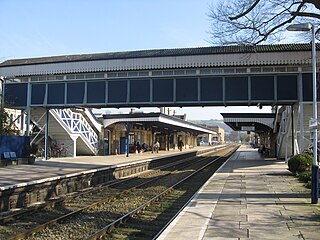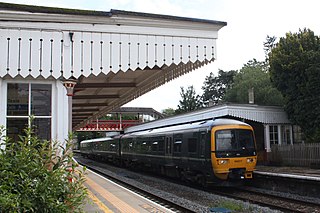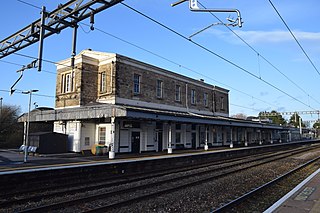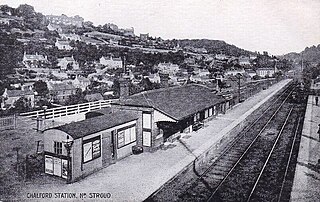
The Thames and Severn Canal is a canal in Gloucestershire in the south-west of England, which was completed in 1789. It was conceived as part of a cargo route from Bristol and the Midlands to London, linking England's two largest rivers for better trade. The route climbs the steep Cotswold escarpment through the Golden Valley, tunnels underneath the summit of the Cotswold Edge, and emerges near the source of the Thames.

Stonehouse railway station serves the town of Stonehouse in Gloucestershire, England. The station is a stop on the Golden Valley Line between Swindon and Gloucester; it is located 104 miles 74 chains (168.9 km) down the line from London Paddington.

Stroud railway station serves the market town of Stroud in Gloucestershire, England. It is a stop on the Gloucester–Swindon Golden Valley Line and was designed by Isambard Kingdom Brunel. It is located 102 miles 13 chains (164.4 km) west of London Paddington.

Kemble railway station is a railway station that serves the village of Kemble in Gloucestershire, England. The station is on the Swindon to Gloucester "Golden Valley" line, 90 miles 79 chains (146.4 km) from the zero point at Paddington. Despite its rural location, Kemble station has a high number of passengers, due mainly to the proximity of Cirencester.

The Gloucester–Newport line is a railway line that runs along the west bank of the River Severn in the United Kingdom between Gloucester and Newport.

The South Wales Main Line, originally known as the London, Bristol and South Wales Direct Railway or simply as the Bristol and South Wales Direct Railway, is a branch of the Great Western Main Line in Great Britain. It diverges from the core London-Bristol line at Royal Wootton Bassett beyond Swindon, first calling at Bristol Parkway, after which the line continues through the Severn Tunnel into South Wales.
The Bristol and Gloucester Railway was a railway company opened in 1844 to run services between Bristol and Gloucester. It was built on the 7 ftBrunel gauge, but it was acquired in 1845 by the 4 ft 8+1⁄2 instandard gauge Midland Railway, which also acquired the Birmingham and Gloucester Railway at the same time.

Swindon railway station is on the Great Western Main Line in South West England, serving the town of Swindon, Wiltshire. The station is 77 miles 23 chains down the line from the zero point at London Paddington and lies between Didcot Parkway and Chippenham. It is managed by Great Western Railway, which also operates all of the services from the station. It is the busiest station in Wiltshire, and the fifth busiest station in South West England.
The Cheltenham and Great Western Union Railway was a railway company intended to link Cheltenham, Gloucester and Swindon, in England. It was authorised in 1836 but it found it very hard to raise money for the construction, and it opened only a part of its line, between Swindon and Cirencester, in 1841. It sold its business to the Great Western Railway, which quickly built the line through to Gloucester in 1845 and Cheltenham in 1847; part of that route was shared with other companies.

Ham Mill Halt was opened on 12 October 1903 on what is now the Golden Valley Line between Kemble and Stroud. This line was opened in 1845 as the Cheltenham and Great Western Union Railway from Swindon to Gloucester and this was one of many small stations and halts built on this line for the local passenger service. This halt opened with the introduction of the GWR steam railmotor services between Stonehouse and Chalford.

Brimscombe Bridge Halt was opened on 1 February 1904 on what is now the Golden Valley Line between Kemble and Stroud. This line was opened in 1845 as the Cheltenham and Great Western Union Railway from Swindon to Gloucester and this was one of many small stations and halts built on this line for the local passenger service. This halt opened following the introduction of the GWR steam railmotor services between Stonehouse and Chalford. The halt was between Brimscombe and Stroud, and featured staggered platforms either side of the overbridge for the local road "Brimscombe Hill", with the down platform on the East side and the up platform on the West. Access to the basic wooden platforms was from the overbridge. Each with GWR pagoda style shelters soon after opening and electric lighting was installed in February 1939 at an estimated cost of £90.

St Mary's Crossing Halt was opened on 12 October 1903 on what is now the Golden Valley Line between Kemble and Stroud. This line was opened in 1845 as the Cheltenham and Great Western Union Railway from Swindon to Gloucester and this was one of many small stations and halts built on this line for the local passenger service. This halt opened with the introduction of the GWR steam railmotor services between Stonehouse and Chalford.

The Tetbury branch line was a 7.5-mile (12.1 km) single-track branch railway line that connected Tetbury with the main line at Kemble on the line between Swindon and Gloucester.

The Cirencester branch line was a five-mile-long single-track branch railway line in Gloucestershire, England that connected Cirencester to the main line at Kemble. It was opened by the Cheltenham and Great Western Union Railway in 1841. The main line was extended from Kemble to a junction near Gloucester in 1845, by the GWR which had taken over the C&GWUR. The branch supported a busy passenger and goods business, but these declined in the 1930s, and closure was threatened in the 1950s. To reduce costs and maintain the viability of the line, lightweight four-wheel diesel railbuses were introduced, and they proved popular. Nevertheless, the line's decline was inexorable, passenger service closed in 1964 and the goods service ending the following year.

Tetbury Road railway station was built by the Cheltenham & Great Western Union Railway to serve the Gloucestershire villages of Kemble and Coates, and the town of Tetbury.

Westerleigh Junction is a railway junction in Gloucestershire, England, where the Cross Country Route (XCR) from York to Bristol Temple Meads meets the South Wales Main Line (SWML) from London Paddington to Swansea, near the village of Westerleigh.

Chalford railway station was situated on the Great Western Railway's Golden Valley Line, between Swindon and Gloucester. It was just east of the bridge carrying Cowcombe Hill over the railway. To the east of the station site lies Chalford Viaduct, and beyond that, Sapperton Long Tunnel.

Minety and Ashton Keynes railway station serving the village of Minety in Wiltshire, England, was opened in 1841 on the former Cheltenham and Great Western Union Railway line from Gloucester to Swindon; it was originally called just Minety.

Purton railway station was in operation on the Swindon to Gloucester line in Wiltshire, England, between 1841 and 1964.




















